6.11 Rail travel in Germany
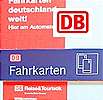 Since German reunification in 1990, much effort has been put into improving the transport links within Germany, especially between the former East German states and the West. This was not easy: Until that time, German trains had been run by two separate state-owned, deficit-ridden operations. The Deutsche Bundesbahn (DB) or German Federal Railway was the old West German railway that had been running things there since Germany's division in 1949. The Deutsche Reichsbahn (DR) or German Imperial Railway in former East Germany kept the pre-war name of the railroad that Hitler and those before him had known. Since German reunification in 1990, much effort has been put into improving the transport links within Germany, especially between the former East German states and the West. This was not easy: Until that time, German trains had been run by two separate state-owned, deficit-ridden operations. The Deutsche Bundesbahn (DB) or German Federal Railway was the old West German railway that had been running things there since Germany's division in 1949. The Deutsche Reichsbahn (DR) or German Imperial Railway in former East Germany kept the pre-war name of the railroad that Hitler and those before him had known.
In 1994, the two German state railroads that had tried to act as one since reunification were merged into the Deutsche Bahn AG - and privatised. This was in part an effort to get the government out from under billions of marks of mounting debt.
The flagship of the new enterprise is the InterCityExpress (ICE), which has been operating on several high-speed lines between major German cities like Berlin, Hamburg and Munich. Over 700 million people travelled by ICE between 1991 and 2007. The newest high-speed line in Germany, the Nuremberg-Ingolstadt high-speed rail line, which opened in May 2006, is the most recent addition to the ICE network. It is one of two lines in Germany (along with the Cologne to Frankfurt line) that is equipped for line speeds up to 300 km/h. On June 10, 2007, a new line between Paris and Frankfurt/Stuttgart was opened, jointly operated by Deutsche Bahn and SNCF. Click
here for a map of the German ICE network.
The sleek, white ICE trains whisk passengers along in quiet, comfortable carriages equipped with video screens (in first class), stereo headsets, fax machines, and telephones. The InterCity Night trains are modern hotels on wheels which operate daily on the routes Munich-Berlin, Frankfurt-Bonn-Berlin and Hamburg-Munich. You can choose between three categories: Comfort Schlafwagen (= a sleeper compartment with private facilities), Comfort (= couchettes) and Comfort Sitzwagen (= with reclining seats and a footrest). Trains similar to the ICEs, with the same internationally stipulated quality standards, connect Germany with the major cities of neighbouring countries. They are called EuroCity (EC) trains.
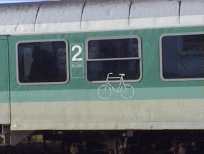 Given the fact that flying between Germany cities is expensive and often subject to delays, you are much better off travelling by rail. The ICE gets from Munich to Frankfurt, for example, in just over three and one-half hours, and once a new high speed track is completed the trip from Frankfurt to Cologne will be less than an hour. The ICE trains are supplemented by InterCity (IC) and InterRegio (IR) express trains. The latter usually run every two hours, have a maximum speed of 200 kilometres per hour, and link major cities to the medium-sized ones and to holiday destinations in Germany and neighbouring countries. They often use double-decker trains nowadays and are timetabled to connect with the railway's long-distance network. Given the fact that flying between Germany cities is expensive and often subject to delays, you are much better off travelling by rail. The ICE gets from Munich to Frankfurt, for example, in just over three and one-half hours, and once a new high speed track is completed the trip from Frankfurt to Cologne will be less than an hour. The ICE trains are supplemented by InterCity (IC) and InterRegio (IR) express trains. The latter usually run every two hours, have a maximum speed of 200 kilometres per hour, and link major cities to the medium-sized ones and to holiday destinations in Germany and neighbouring countries. They often use double-decker trains nowadays and are timetabled to connect with the railway's long-distance network.
Despite their names, der Schnellzug (D) (literally: "the fast train") and
der Eilzug (E) (= a fast stopping train) are much slower than the ICE trains, whereas der Nahverkehrszug (= literally: "local transport train") will stop at all the local stations before reaching its final destination.
Buying a ticket
When booking a train ticket in Germany, it certainly pays to ask if there are any special reductions (Ermäßigungen). There are also of course reduced fares and special deals for senior citizens (Senioren) and children and teenagers (Junioren), as well as special holiday tickets (das Ferienticket) (see left). Travellers might also consider the Schönes Wochenende Ticket (= literally: "Nice Weekend Ticket"). This provides weekend travel on local trains only for up to five persons travelling together.
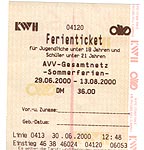
But the perhaps the biggest price-slasher for the regular visitor is die BahnCard, a railpass valid for a whole year, giving you a 25% reduction on all fares. It costs 55 euros for second class travel and 110 euros for first class travel. Other versions of the BahnCard give you 50% and 100% reduction on train travel, but you need to pay more for them. You can get more information on the BahnCard by clicking here.
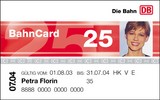
 |
Web Links |
 |
| Web sites on the German rail network |
 |
Deutsche Bahn AG |
The homepage of Germany's privatised rail company also has an English version. |
 |
Die BahnCard |
What the BahnCard is and how can you acquire one? |
 |
ICE-Fanpage |
Everything you could possibly want to know about the InterCity Express. |
 |
The ICE crash at Eschede |
Information about the horrific ICE crash in Eschede in June 1988 which claimed 100 lives. |
 |
Berliner Verkehrsseiten |
Markus Jurziczek's website offers information about the local transport system in Berlin. |
 |
Eurail |
How to buy a Eurail ticket and travel across Europe by rail. |
|
 Chapter 6: Exercises Chapter 6: Exercises
 Nach oben Nach oben
 Print This Page Print This Page
|